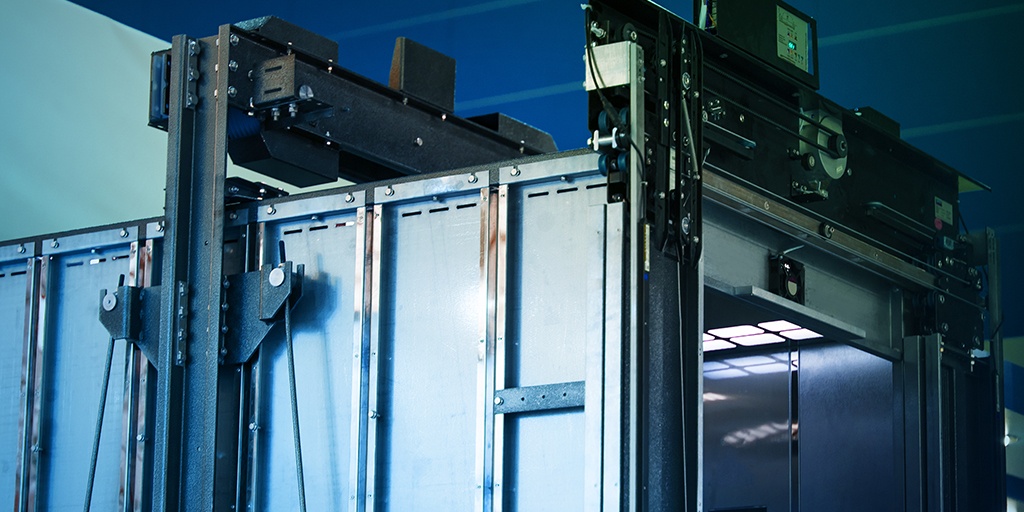According to the Roman architect Vitruvius, elevators have been around since about 236 BC, when Archimedes built the first primitive hoisting platform. Since then, they’ve appeared in various forms. Not only did Louis XV use a servant-hoisted “flying chair” to connect his apartment with that of his mistress in 1743, but two enterprising gentlemen in 1823 also built a steam-powered lift that raised tourists 121 feet into the air for a better view the London skyline.
However, it wasn’t until 1852 that Elisha Otis patented his “Life and Labor Saving Hoist Machinery” (AKA a safe elevator) and went on to demo it with great fanfare at the 1853-54 World’s Fair in New York City. From then on, the contraption was widely recognized and has remained popular ever since.
Current estimates suggest that there are more than twelve million elevators worldwide, with at least 62,000 here in the city, but it all started with the first elevator to ever hit New York.
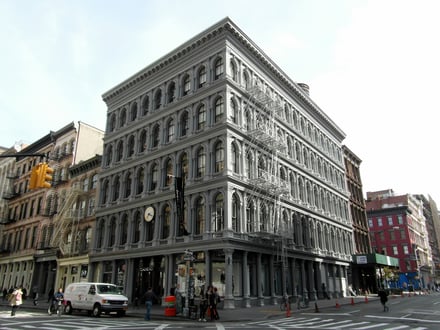
First Passenger Elevator: E.V. Haughwout Building
Photo Credit: 'E V Haughwout & Co Store' by Tom Bastin under CC BY 2.0
On March 23, 1857, three years after Otis’ death-defying presentation at the World’s Fair, he installed the first passenger elevator right here in New York, at what was then known as the E.V. Haughwout Department Store. At that time, the elevator cost just $300, traveled just under 0.5mph, and was powered by a steam engine in the basement.
At just five stories, the Haughwout Building wasn’t actually tall enough to require an elevator, but the business-savvy owner knew that installing a passenger elevator as an in-store attraction would draw a crowd of potential customers. His plan apparently worked: Even Mary Todd Lincoln made her way out to Haughwout’s to purchase the official White House china in 1861.
The original elevator was replaced in the 1890s, presumably to update to the far less sooty electric model, but this 1890s elevator remained in use all the way until 2001.
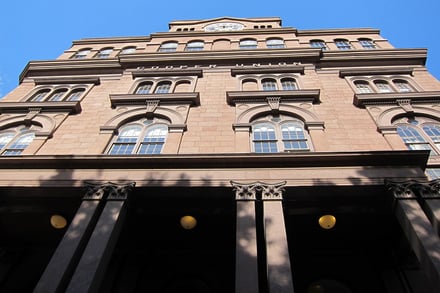
Photo Credit: 'NYC - East Village: The Cooper Union Foundation Building' by Wally Gobetz under CC BY-NC-ND 2.0
One mile from the E.V. Haughwout Building stands what was once (like so many others) one of lower Manhattan’s tallest buildings. At seven stories high, the Cooper Union Foundation Building needed an elevator to transport guests to their destination.
There was just one problem: Passenger elevators had yet to be invented.
When the building’s owner, noted industrialist and inventor Peter Cooper, planned the building, he knew its enormous height would require a safe, passenger elevator, and— forward-thinking man that he was— he included an elevator shaft in the plans because he suspected elevators would soon become available.
A practical man, Cooper reasonably assumed that elevators would be round, since that was the optimal shape for carrying the largest load of passengers comfortably. Evidently, Otis never concerned himself with the scientific passenger load calculations, as his elevators bore the more familiar box shape that we all know.
Luckily, Cooper’s son, Edward Cooper, built a round, steam-powered elevator for the Cooper Union Foundation Building in the 1850s. Within forty years, though, this elevator was upgraded to Otis’ newest, electrically powered box-shaped elevator. Those 1890s elevators must have been resilient, because the electric one wasn’t updated until 1972 when architect John Hejduk created a special, round model for the building.
If you visit the Cooper Union Foundation Building today, you too can ride in the strange, round elevator housed in the world’s very first elevator shaft.
By the way, the world’s first electric elevator was also here in New York City. It was built in the Demarest Building in 1889 by Renwick, Aspinwall & Russell, who also worked on the fascinating Smallpox Hospital of 1856.
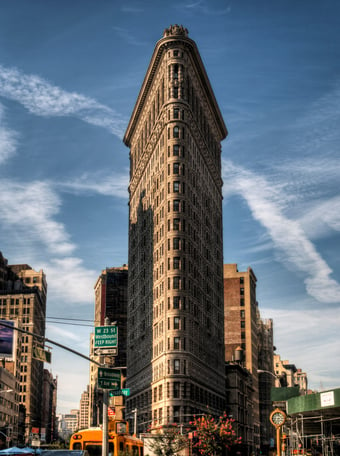
Last Remaining Hydraulic Elevator: Flatiron Building
Photo Credit: 'The Flatiron Building, New York' by Neil Howard under CC BY-NC 2.0
With its bizarre shape, exciting construction stories, and chest-high, upper-floor windows (apparently, you can only see out of them “if [you] stand up”), the Flatiron Building certainly has its share of oddities. But how many people realize that this 1902 edifice also featured the last remaining water hydraulic elevator?
Operated manually using a highly sensitive system, water hydraulic elevators could have provided either a smooth ride or a jostling experience. They were slow, too. Reports from the early 1900s complained that the elevators in the Flatiron Building were both slow and bouncy, and John J. Murphy III, the director of publicity for St. Martin’s, reported that his commute from his apartment across the street took a whopping thirty minutes.
Slow rides and frequent breakdowns on the historic elevator meant that modern Flatiron tenants were more likely to take the stairs to work, and when the elevator was finally upgraded in 1999, a local elevator installer expressed relief that he would no longer have to deal with water bugs.
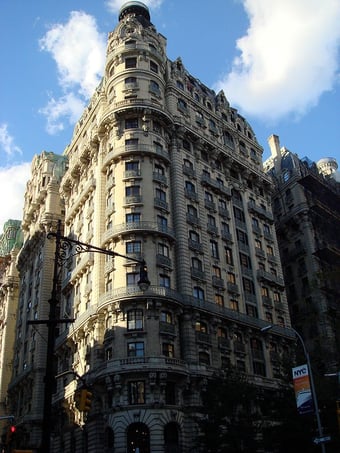
Cattle Elevator: The Ansonia
Photo Credit: 'The Ansonia 1' by Kurpfalzbilder.de under CC BY-SA 2.0
Owned by William Earle Dodge Stokes, the scandalous heir to the Phelps-Dodge copper fortune, the Ansonia opened in April 1904 and was billed as the “grandest hotel in Manhattan” by contemporaries. The seventeen-story structure had 1,400 rooms, 300 suites, Turkish baths, the world’s largest indoor swimming pool, and futuristic tubes that delivered messages throughout the hotel.
It also had 500 chickens, many ducks, six goats, a small bear, and dairy cows – all housed in the building’s rooftop farm. This sounds like adaptive reuse well before its time!
All those animals needed an easy way to and from the roof, so the building also featured a cattle elevator to give dairy cows an express ride. The eccentric Stokes also used the hotel elevators to carry his pet pig named Nanki-Poo, his apparently nameless pet goose, and his forty-seven pet chickens back and forth to his suite. In her divorce papers, Stokes’ wife stated that those chickens were one of the reasons she had to leave. (We can’t make this stuff up, folks!)
Alas, the rooftop farm was shut down in 1907 by the Department of Health and the hotel suffered a large number of scandals in the ensuing years.
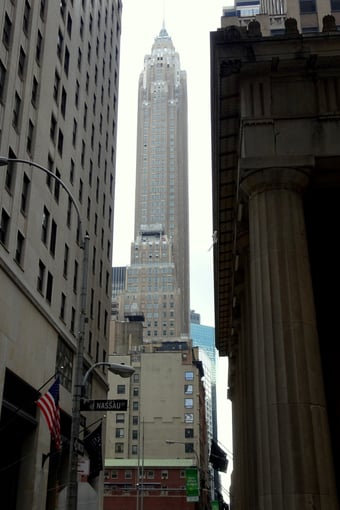
Double-Decker Elevator: 70 Pine Street
Photo Credit: 'American International Pine Street jeh' by Jim.henderson under CC BY 4.0
History shows that the elevator was one of the deciding factors that ultimately made skyscrapers possible, so it only makes sense that one of the world’s tallest buildings would have a unique elevator.
70 Pine Street, known then as the Cities Service Building, was completed in 1932 and featured a double-decker elevator to transport guests swiftly to their destination among the building’s sixty-seven stories. The double-decker design allowed for the building to have more elevators in fewer shafts, saving $200,000 in construction costs and freeing up 40,000 square feet of usable space in the building to add estimated yearly revenues of $140,000 in rent.
Not only were the innovative elevators a cost saver, they were also a time saver. During peak hours, their flexible design allowed them to run double-decker to enable foot traffic to pass through quickly, while during off-peak hours, they were also capable of running separate elevator cars to each floor.
However, following a change in office hours and foot traffic patterns in the 1960s, the building landlords replaced the double-decker elevators with standard elevators. They have no plans to replace them at this time.
The Future of New York City’s Elevators
Our city has been a shining example throughout the history of elevators, but with new ‘supertall’ and ‘megatall' skyscrapers going up all the time (each of which feature ever-thinner profiles like at 432 Park), we will need to start thinking ‘outside of the box’ when considering the role and function of elevators. (Pun intended!)
As we think, though, we need to consider the significance of elevators. They are the most used urban transport system, surpassing subways, busses, or any other transport system you can think of, and they are critical to our city’s infrastructure.
A study by Columbia University students found that New York City’s office workers spent a collective 5.9 years riding in elevators and 16.6 years waiting for elevators during 2010 alone. Saving space in ‘supertall', super thin buildings is certainly an important concern, but cutting out elevator space may not be the answer because saving time is also extremely important.
Some new inventions, such as the MAX IoT device from ThyssenKrupp, monitor your elevators’ maintenance needs using a cloud-based tablet you can attach to your elevators and set up in as few as fifteen minutes. By maintaining a proactive approach toward elevator maintenance, MAX suggests it can reduce elevator waiting time by up to 50% – which means that if all the buildings in NYC were to install these, we would collectively save eight years of our lives waiting for elevators.
Other inventions seek to revolutionize the elevator concept entirely, such as the new, magnetically powered, cable-free MULTI elevators, also from ThyssenKrupp, which can move multiple elevators through a shared, building-wide shaft system with cars that can move both horizontally and vertically. This idea is being tested in Germany as you read this, and it may be something that we, as architects, all need to consider implementing soon.
It is time for us to rethink the elevator, and if we can all contribute, we may be able to come up with a new, brilliant solution that changes the world – much like Elisha Otis’ safety elevator did in the 1800s.
Subscribe to the Insights blog for fascinating reads and important NYC updates, delivered right to your inbox.

